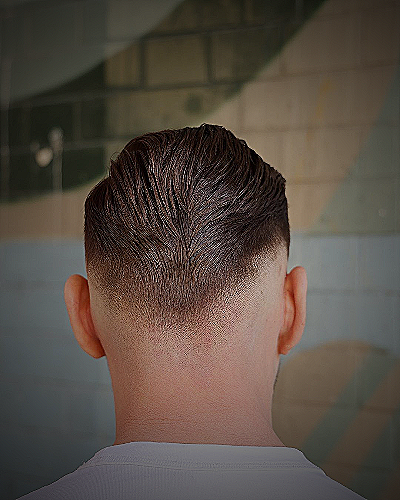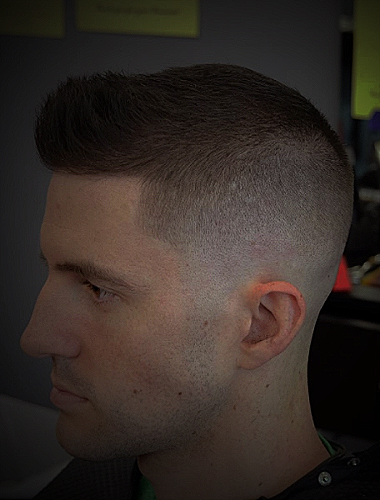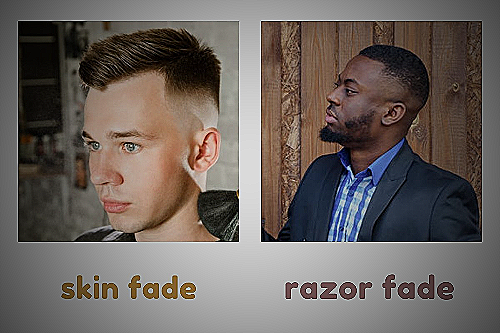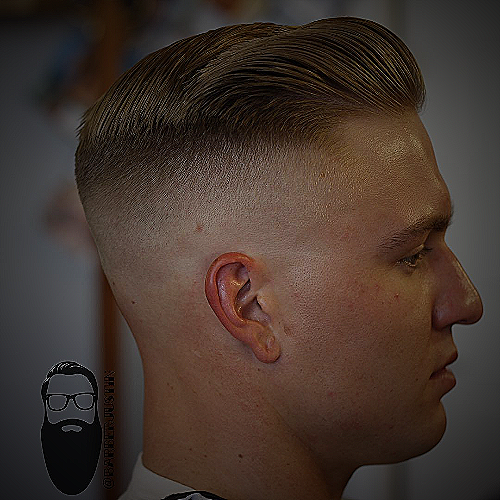In 2023, the zero fade and skin fade haircuts continue to dominate men’s grooming trends. These modern, versatile styles cater to various tastes and preferences, offering a fresh, clean look that keeps you ahead of the game.
Let’s differentiate between the zero fade and skin fade, and explore why they’ve become such popular choices in today’s fashion scene.
What Is a Zero Fade?
A zero fade is a type of taper fade haircut that leaves a small amount of hair near the base of the neck, creating a seamless transition from hair to skin. Unlike a skin fade, which completely shaves the hair down to the skin, a zero fade maintains a subtle presence of hair around the edges.
Popular zero fade styles include the pompadour, quiff, and comb over, which can be combined with the fade for a modern and versatile look. The zero fade offers flexibility in styling and is suitable for various hair types and face shapes.

Who Should Get a Zero Fade?
A zero fade haircut is ideal for individuals with various hair types and face shapes, as it offers a modern and versatile look. This style works well with straight, wavy, and curly hair, providing a clean and stylish appearance.
When considering face shapes, the zero fade complements most, including oval, square, and round faces. The pros of choosing a zero fade include its adaptability to various hair lengths and styles, easy maintenance, and a sharp, polished look.
However, the cons may include frequent salon visits to maintain the fade and potential limitations in styling options for extremely short hair.
How to Get a Zero Fade
A zero fade is a tapering fade haircut for men, where the hair is shaved down to next-to-nothing on a gradient, while still leaving some hair near the base of the neck. To achieve this modern look, follow these step-by-step instructions:
1. Comb out the hair
Start by combing the hair to ensure it’s all even and tangle-free. This will make it easier to trim and fade the hair.
2. Trim the sides
Using a clipper with a guard, trim the sides of the hair to your desired length. This will create the foundation for the zero fade.
3. Create the shadow fade
Begin the fading process by using a smaller guard on the clipper and blending the hair from the bottom up. This creates a smooth transition from the shorter hair at the base to the longer hair on top.
4. Trim uneven hair
After creating the shadow fade, check for any uneven hair and trim it accordingly to maintain a clean and polished look.
5. Fade the number one into the double zero
Continue the fading process by blending the number one guard into the double zero guard. This creates a seamless transition from the longer hair to the shorter hair at the base of the neck.
6. Fade the number two into a number one
Using the number two guard, blend it into the number one guard. This further enhances the gradient effect of the zero fade haircut.
7. Style the front hair
Finish the haircut by styling the front hair to your preference. This can include slicking it back, creating a pompadour, or adding texture with styling products.
8. Apply your preferred cream and style
Complete the zero fade haircut by applying your preferred styling cream or product and styling the hair as desired.

To maintain a zero fade, regular trims and touch-ups are necessary. Additionally, using quality hair care products will help keep your hair healthy and looking its best.
Who Should Get a Skin Fade?
A skin fade is a popular and stylish haircut that works well with various hair types and face shapes. It is best suited for individuals who have a well-defined jawline, as it accentuates the facial features and adds a modern, edgy look to the overall appearance.
However, those with round or softer facial features can also rock a skin fade by opting for a longer length on top to balance out the sharpness of the fade.
There are pros and cons to choosing a skin fade haircut. On the positive side, a skin fade is low-maintenance and can add a clean, polished look to any hairstyle.
Additionally, it can make thinning hair appear fuller and give a more youthful appearance. On the downside, a skin fade may require more frequent visits to the barber to maintain the sharpness of the fade, and it may not be suitable for those with sensitive skin or scalp conditions.
Ultimately, the decision to get a skin fade should be based on your personal style, hair type, and lifestyle preferences.
How to Get a Skin Fade
Getting a skin fade haircut involves a gradual transition from short hair at the sides and back of the head to even shorter or bald near the ears and neckline. Here’s a step-by-step guide to achieve a skin fade:
Step 1: Prepare the Hair
First, wash and dry your hair thoroughly. Comb it to remove any tangles and ensure it’s all even.
This makes the cutting process easier and more precise.
Step 2: Choose the Right Tools
Select the appropriate clippers, guards, and trimmers for the job. Having the right tools is crucial for a clean and professional-looking skin fade.

Step 3: Start with the Sides
Begin by trimming the sides of your hair using a clipper with a suitable guard size. This creates a baseline for the fade and makes it easier to blend later on.
Step 4: Create the Fade
Switch to a lower guard size and start blending the hair from the baseline upwards. Continue to switch guards and blend the hair until you achieve a smooth transition from short to shorter hair.
Step 5: Skin the Bottom
Remove the guard and use the clipper to trim the hair at the very bottom of the fade, close to the ears and neckline. This creates the “skin” part of the skin fade.
Step 6: Refine the Fade
Go back through the fade with a trimmer or detailer to clean up any uneven areas and ensure a smooth transition between the different hair lengths.
Step 7: Trim the Top
Use scissors or clippers with a longer guard to trim the hair on top of your head to the desired length, blending it with the sides if necessary.
Step 8: Style and Finish
Apply your preferred styling product and style your hair as desired. A well-maintained skin fade looks best with a clean and polished finish.
Remember, practice makes perfect when it comes to achieving a skin fade. If you’re unsure about doing it yourself, consult a professional barber for a precise and well-executed haircut.
Skin Fade vs Zero Fade: What’s the Difference?
Both skin fades and zero fades are popular taper fade haircuts for men, but they have some key differences. A skin fade is a zero-grade cut that is shorter at the bottom, revealing more of the scalp.
It is expertly blended so that it’s difficult to see where the fade ends. On the other hand, a zero fade is a taper fade that leaves some remaining hair near the base of the neck.
This makes it less dramatic than a skin fade, but still provides a clean, modern look.
Choosing between a skin fade and a zero fade ultimately depends on personal preference and the desired level of contrast. A skin fade might be more appropriate for those seeking a bold, edgy look, while a zero fade offers a more subtle and versatile option.
Both styles can be combined with various hairstyles to create a unique and personalized appearance.

Skin Fade vs Zero Fade vs Bald Fade: Which Should You Get?
When it comes to choosing the perfect fade for your hairstyle, it’s essential to understand the differences between skin fade, zero fade, and bald fade. Each type has its own unique characteristics, and selecting the right one depends on factors such as your hair type, face shape, and personal preferences.
Skin Fade
A skin fade, also known as a bald fade, is a haircut where the hair gradually fades from a longer length at the top to completely bald at the sides and back. This style reveals more of the scalp and creates a sharp, clean look.
The skin fade requires precision and expertise, as the blend should be seamless, making it difficult to see where the fade ends.
Zero Fade
On the other hand, a zero fade is a taper fade haircut that leaves some hair near the base of the neck. The hair is shaved down to almost nothing on a gradient, with the final part of the gradient being very short but not completely bald.
This style is versatile and can be combined with various hairstyles for a modern look. A zero fade haircut typically involves the following steps:
- Comb out the hair to ensure it’s all even
- Trim the sides
- Create the shadow fade
- Trim uneven hair
- Fade the number one into the double zero
- Fade the number two into a number one
- Trim the front hair
- Apply your preferred cream and style
Bald Fade
A bald fade is essentially the same as a skin fade, where the hair is faded down to the scalp. It’s a popular choice for those who want a sleek, sharp look with minimal maintenance.
The bald fade also requires a skilled barber to achieve a seamless blend and finish.
Choosing the Right Fade for You
To decide which type of fade is best for you, consider the following factors:
- Hair type: If you have thick or curly hair, a skin or bald fade might be more suitable, as it can help reduce bulk and create a cleaner look. A zero fade might work better for those with fine or straight hair, as it leaves some length near the base of the neck.
- Face shape: A skin or bald fade can help elongate the face and create a more balanced appearance for those with round or square face shapes. On the other hand, a zero fade can add width to the sides of the face, making it a better option for those with longer or more angular face shapes.
- Personal preference: Ultimately, your choice of fade should reflect your personal style and preferences. If you prefer a more edgy, modern look, a skin or bald fade might be the way to go. If you want a more classic, versatile style, a zero fade could be a better option.
By understanding the differences between skin fade, zero fade, and bald fade haircuts, you can make an informed decision about which style is best suited for your hair type, face shape, and personal preferences.
Frequently Asked Questions
What Is the Difference Between a Zero Fade and a Skin Fade?
What Tools Do I Need to Achieve a Zero Fade or Skin Fade?
Can I Achieve a Zero Fade or Skin Fade at Home?
Conclusion
In summary, the key difference between a zero fade and a skin fade lies in the length of hair remaining near the base of the neck. A zero fade leaves some hair, while a skin fade reveals more of the scalp with a shorter cut at the bottom.
Choosing between these two fades depends on individual preferences, hair types, and face shapes, so consider your personal style when deciding on the perfect fade for you.
